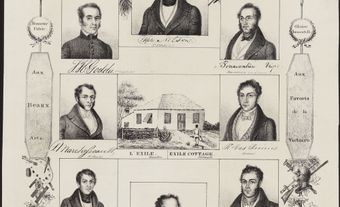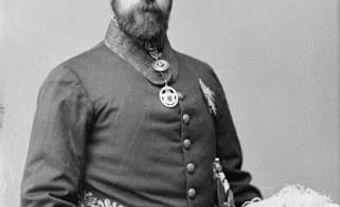Leadership Convention
A leadership convention is a meeting of party members to select a leader of the party. Of the countries deriving their parliamentary system from the Westminster model, Canada alone has adopted and modified the American national party convention as the means for choosing its party leaders. For more than 50 years after CONFEDERATION the parliamentary parties (caucuses) chose their leaders from among their own members - senators and MPs - but in 1919 that system came to an end when Sir Wilfrid LAURIER called a national party convention to discuss policy and organization. Between the time the call went out to the 1135 delegates and the time they assembled some months later in Ottawa, Laurier died. The party executive seized the opportunity to convert the meeting into a forum for selecting the new leader.
The convention came at an ideal time for the Liberals. The 1917 "Conscription Election" had split the party, and its forces in Parliament were small and drawn overwhelmingly from Québec. A truly "national" convention presented the party with the opportunity to widen considerably the number of participants in its leadership-selection process. It was decided that an equal number of delegates was to be sent by each federal constituency association. At the same time the party executive accepted as a second principle the notion that a clear majority of delegates should come from the constituencies - the minority being made up of party officials, MPs, senators and provincial legislators.
Both principles have been applied by the LIBERAL PARTY and the Progressive CONSERVATIVE PARTY (though not the CO-OPERATIVE COMMONWEALTH FEDERATION, now the NEW DEMOCRATIC PARTY, which has based its constituency representation on the size of party membership lists at the local level) in every national leadership convention since 1919. They have lent support to the common claim of Canadian politicians that leadership conventions are more democratic and representative than any alternative method of choosing party leaders. The delegates (whose numbers have varied from 2500 to 4700 in recent conventions) vote secretly and individually. No additional names may be placed in nomination once the voting has begun, and the candidate with the fewest votes is dropped after each ballot until one candidate has won a clear majority of the votes cast. If no majority winner is declared on one ballot, voting resumes straight away on the next. All of these rules stand in marked contrast to those of an American convention and contribute to the uniqueness of Canadian leadership conventions.
The effect of the rules is to force many delegates and candidates in multi-ballot conventions to reconsider their options and to vote for a candidate on later ballots other than their most preferred one on the first ballot. This promotes "strategic" voting on successive ballots, and prompts most candidates who withdraw or are gradually eliminated from the race to "throw their support" on the convention floor behind an erstwhile opponent. Strategic delegate voting and candidate coalition-making was best demonstrated by the outcome of the 1983 Progressive Conservative convention. Support for the Anybody But Clark (ABC) movement in the party grew to such an extent over the convention's 4 ballots that the front-runner on the first 3 ballots (Joe Clark, who had been elected leader by convention 7 years earlier) was defeated on the fourth vote by the ABC's most preferred alternative, Brian Mulroney.
While leadership conventions have compensated to a very substantial degree for the regional imbalances of the parliamentary parties, they have at the same time effectively ended the caucus's monopoly over the selection of a party leader, with a curious result. "Outsiders" (those with little or no prior parliamentary experience) stand a greater chance of being chosen party leader than those who have devoted many years to a parliamentary career and who, in many cases, have served for a long period of time on the Government or Opposition frontbenches. The first 5 leaders of the Liberal Party chosen by national leadership conventions, W.L. Mackenzie KING (1919), Louis ST-LAURENT (1948), Lester B. PEARSON (1958), Pierre Elliott TRUDEAU (1968) and John TURNER (1984), fall into this category.
Of the Liberal leaders chosen this century (all of whom went on to become prime minister) only Jean Chrétien had had an extensive parliamentary career - 25 years - prior to his selection. Even so, at the time of his selection as party leader (1990) Chrétien, like Turner 6 years earlier, was not an MP. He had withdrawn voluntarily from parliamentary life 3 years previously to enter an Ottawa law firm and, again like Turner, to position himself through reinvigorated contacts with his political network and the extra-parliamentary party to win its support for his eventual drive for the Liberal leadership.
For its part, the Conservative Party has selected 3 provincial premiers as national leaders. Not one had stood for election to Parliament before his selection: John BRACKEN (1942), George DREW (1948) and Robert L. STANFIELD (1967). After only 3 1/2 years in Parliament, Joe CLARK in 1976 defeated 10 other candidates (some of whom had had lengthy political careers) to become, at the age of 36, Canada's youngest national party leader.
Brian Mulroney, a man who had never previously been nominated for or elected to public office at any level of government, was succeeded a decade later by Kim CAMPBELL, Canada's first female prime minister. Campbell, whose government suffered an electoral defeat of unprecedented proportions 6 months later, had served, prior to winning her party's leadership, less than 5 years as an MP and Cabinet minister. Of the Conservative leaders chosen by convention, only R.B. BENNETT (1927) and John G. DIEFENBAKER (1956) had had extensive prior parliamentary experience.
Convention delegates obviously look for qualities other than parliamentary and Cabinet experience when choosing their party's leader. Success in previous provincial elections, reputations earned in administrative, industrial and extra-political spheres, and potential electoral attractiveness count for more than lengthy service in Parliament. It is debatable whether the openness and freedom inherent in the leadership-convention system, with its challenge to established career patterns and recruitment practices, is necessarily beneficial to the larger political system. The record suggests that the leadership convention process actually serves as a disincentive to those who might aspire to a lengthy parliamentary career capped by a successful run at their party's leadership.
Canadian leadership conventions are not held at regular, stated intervals. Thirty years passed between the first and second Liberal leadership conventions - an unrivalled hiatus that would no longer be tolerated by the press, public and politicians. Leadership conventions are now typically called every 8 to 10 years when, for example, the leader no longer feels equal to the task (St-Laurent and Drew); when he is convinced there is little likelihood of the party gaining office under his leadership (Bracken, Stanfield and Turner); or when, as prime minister, he is satisfied that the time has arrived for handing over the reins of power as the party could well go down to electoral defeat were he not to resign (King, Pearson, Trudeau and Mulroney).
The decade following the Progressive Conservative convention of 1983 and the Liberal convention of 1984 ushered in an era of party soul-searching and, ultimately, reform. The 1983 and 1984 contests, together with the Tory convention of 1976 and the Liberal one of 1990, had gained widespread attention at the time for their often bitter organizational rivalries among candidates, stacked delegate selection meetings in constituencies, and dirty tricks at the riding level. By the early 1990s traditional leadership conventions had been cast in an odious light. Media commentators, opinion leaders and party activists called for alternative forms of choosing leaders at both the national and provincial levels.
These developments coincided roughly with the arrival of the REFORM party on the national scene. Its message of direct and universal participation in political decision-making, given an added legitimacy by the party's electoral success in 1993, matched the calls for increased intra-party democracy in the older parties. The upshot of the often heated debates within all parties about the most appropriate way to choose leaders in an era of direct democracy was the one-member, one-vote alternative.
At the 1995 Progressive Conservative convention, at which Jean Charest was unopposed in his bid to succeed Kim Campbell, the Tories approved a proposal whereby future leaders would be chosen by a direct vote of all party members in the entire country. This closely resembled the universal membership vote method the Reform party had previously accepted for choosing its leaders. With a more complex membership structure drawn from constituency parties and trade unions, the NDP opted for a two-stage vote on its leadership changeover. Regional all-membership primaries would be followed by a national convention. The party first used this system when Alexa McDonough (third-placed in the candidate primaries) emerged as the unopposed candidate on the second ballot to succeed Audrey MCLAUGHLIN in 1995. When Jean Chrétien retires as Liberal leader, his successor will be named in a unique constituency primary/national convention system adopted by the party in 1992. Party members attending the constituency delegate selection meetings will, in future, vote twice: once to allocate the number of delegate positions to leadership candidates according to the share of the popular vote, and once to determine which party members will fill the delegate positions at the national convention.
All the recent changes have been aimed at widening party participation in leadership selection and have been justified as procedural improvements that will edify convention democracy. That remains to be seen. The particulars of the schemes by the parties adopted since 1990 may differ, but in varying degrees they all signal the end of leadership conventions as Canadians have known them for almost the entire 20th century.

 Share on Facebook
Share on Facebook Share on X
Share on X Share by Email
Share by Email Share on Google Classroom
Share on Google Classroom


